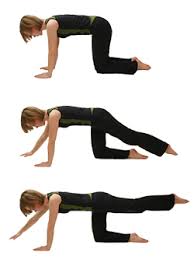Modern Pilates classes
Four Point Kneeling exercise progression explained and demonstrated
10/05/16
Pilates exercises on all fours have fundamentally the same aims, yet the level of challenge within each exercise is dependent on each client's level of advancement.For a beginner, the start position of four point kneeling will undoubtedly be just as challenging as the ‘superman’ exercise for a more advanced client.
The beauty of Pilates is that each exercise can be layered or adapted and progressions added as the client improves their strength and balance.
The aims of all exercises are as follows:-
- To challenge and strengthen core stability
- To challenge and strengthen pelvic stability
- To challenge and strengthen shoulder stability
- To improve bone strength through upper body bone loading

Picture 1 - Four Point Kneeling exercise
Four Point Kneeling (Picture 1)
This is the fundamental start position for all four point kneeling exercises. Hands are directly underneath your shoulders and knees directly beneath the hips. Arms should be fully lengthened but avoid locking your elbows. The chest and the front of your shoulders should be open without tension in the neck area. Notice too the use of a pole to show the correct spinal alignment - the three points of contact being the sacrum (a large triangular bone at the base of the spine), the thoracic spine (between the shoulder blades) and the back of the head.
In this position it’s essential to maintain a neutral pelvis and good abdominal connection to prevent your pelvis and lumbar spine collapsing towards the mat.

Picture 2 - Four Point Kneeling exercise
Pinpoint Arms & Legs (Picture 2)
It’s a fairly big jump from four point kneeling to full pinpoint arms and legs. In reality, we’d build up from four point kneeling by mastering an exercise called ‘Cat Pedals’ first, where each hand is lifted alternately whilst maintaining the abdominal connection, neutral spine and stability in both the shoulders and the pelvis.
After Cat Pedals we can progress through the different elements of pinpoint; the alternate move of the arms maintaining contact with the floor, then the alternate move of the leg whilst maintaining contact with the floor. Once a client is strong in the separate elements, we’d add the opposite arm and leg together, still maintaining contact with the floor. Only once a client is strong and stable in this element would the final progression to a slight lift of the arm and leg occur.

Picture 3 - Four Point Kneeling exercise
Superman (Picture 3)
The natural progression from full pinpoint is Superman where the opposite arm and leg is lifted and lengthened simultaneously. It takes an extreme amount of strength to master the final element of this exercise given its inherent instability and the weight of limb loading against the trunk.
N.B. All these exercises are especially challenging on the wrists, so remember to rest and stretch out the wrists whenever necessary.
Progressions in Pilates exercises should only be performed in line with a client's capabilities. It’s important for you and your Pilates instructor to know your capabilities so that exercises can be progressed at the right pace for you.


